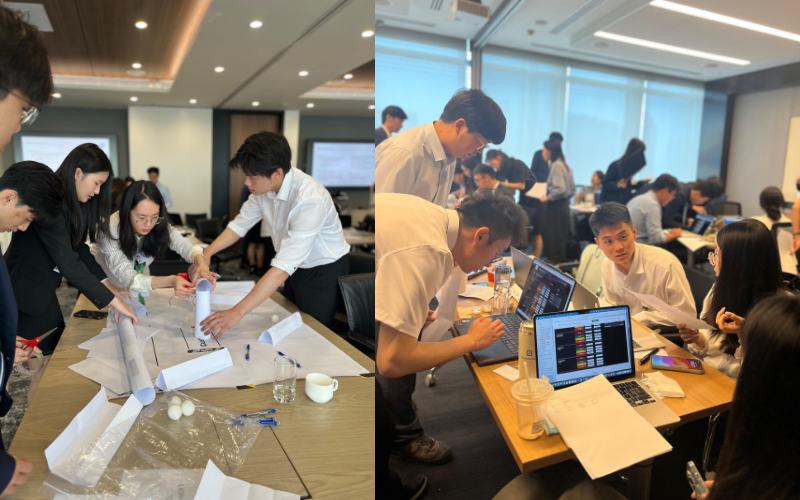Internship Success: How Simulated Environments Prepare Interns for Real-World Challenges?
Internships are a crucial step in the career development of many young professionals. They provide a unique opportunity to gain practical experience, develop new skills, and make valuable industry connections. However, the transition from academic learning to real-world application can be daunting. This is where simulated environments come into play, offering a bridge between theory and practice. In this blog, we will explore how these innovative tools are shaping the future of internships and equipping interns to face real-world challenges with confidence and competence.
The Evolution of Internships
Internships have long been a cornerstone of career development, providing aspiring professionals with a glimpse into the working world and a chance to apply their academic knowledge in a practical setting. Over the years, the concept of internships has evolved significantly, influenced by changes in technology, industry demands, and educational philosophies.
Early Internships: The Foundation
In the early days, internships were primarily apprenticeships in trade and craft industries. Young individuals would learn under the guidance of a skilled master, acquiring hands-on skills and knowledge through direct observation and practice. This model was effective in passing down specialised skills and ensuring a steady supply of trained professionals.
The Rise of Corporate Internships
As industries modernised and the corporate world expanded, the nature of internships shifted. By the mid-20th century, internships began to emerge in corporate settings, offering students opportunities to gain experience in fields such as finance, marketing, and engineering. These internships were often unpaid and focused on giving students a taste of professional life, with tasks ranging from administrative duties to more complex project work.
The Shift to Structured Programmes
In the latter part of the 20th century, companies started recognising the value of structured internship programmes. These programmes were designed to provide more comprehensive training, including mentorship, performance evaluations, and project-based learning. Companies began to see internships not just as a way to get extra help, but as a strategic tool for recruiting and developing future talent.
The Impact of Technology
The advent of digital technology in the 21st century brought significant changes to internships. Technology enabled virtual internships, allowing students to work remotely and gain experience with companies across the globe. Online platforms and tools facilitated collaboration and communication, making it easier for interns to contribute to projects and learn from their mentors.
The Emergence of Simulated Environments
One of the most transformative developments in recent years has been the integration of simulated environments into internship programmes. These environments leverage technologies like virtual reality (VR), augmented reality (AR), and artificial intelligence (AI) to create realistic and immersive learning experiences. Unlike traditional training methods, simulated environments offer a hands-on approach that can be customised to the specific needs of different industries.
Key Milestones in the Evolution of Internships
- Apprenticeships: The origin of internships in trade and craft industries.
- Corporate Internships: The introduction of internships in corporate settings, primarily for administrative and project-based tasks.
- Structured Programmes: The development of formal internship programmes with mentorship, evaluations, and project work.
- Virtual Internships: The rise of remote internships facilitated by digital technology.
- Simulated Environments: The latest innovation, offering immersive, technology-driven training experiences.
What Are Simulated Environments?
In the realm of professional training and development, simulated environments represent a cutting-edge approach that blends technology with experiential learning. These environments are designed to replicate real-world scenarios and settings, providing learners with an interactive and immersive experience. By utilising advanced technologies such as virtual reality (VR), augmented reality (AR), and artificial intelligence (AI), simulated environments offer a safe and controlled space for individuals to practise and hone their skills.
Defining Simulated Environments
Simulated environments can be broadly defined as digital or physical spaces created to mimic real-life situations. These environments can vary widely, from simple software simulations to complex VR systems that provide a fully immersive experience. The key characteristic of a simulated environment is its ability to create realistic scenarios that users can interact with, allowing them to learn through doing rather than just observing.
Key Components of Simulated Environments
- Virtual Reality (VR): VR technology creates a completely immersive experience by simulating a three-dimensional environment that users can interact with using special headsets and controllers. This technology is particularly useful for training in fields such as medicine, aviation, and engineering, where spatial awareness and hands-on practice are crucial.
- Augmented Reality (AR): AR overlays digital information onto the real world, enhancing the user’s perception and interaction with their surroundings. AR can be used in various training scenarios, such as maintenance and repair tasks, by providing real-time guidance and information.
- Artificial Intelligence (AI): AI plays a significant role in creating adaptive and responsive simulations. AI-driven systems can adjust the difficulty level of tasks, provide personalised feedback, and simulate complex interactions, making the learning experience more dynamic and tailored to individual needs.
- Simulation Software: This includes a wide range of applications and platforms designed to simulate specific tasks or processes. Examples include flight simulators for pilots, surgical simulators for medical interns, and trading platforms for finance professionals.
Benefits of Simulated Environments
Simulated environments offer numerous advantages over traditional training methods. Here are some key benefits:
- Hands-on Experience: Simulated environments allow learners to gain practical experience in a controlled setting. This hands-on approach helps them develop and refine their skills before applying them in real-world situations.
- Safe Learning Space: One of the most significant advantages of simulated environments is the ability to make mistakes without real-world consequences. This encourages experimentation and learning from errors, which is crucial for skill development.
- Immediate Feedback: Simulations often include real-time feedback mechanisms that help learners understand their performance and areas for improvement. This immediate feedback loop accelerates the learning process.
- Enhanced Engagement: Interactive simulations are generally more engaging than traditional training methods. The immersive nature of VR and AR, combined with the interactivity of AI-driven systems, keeps learners motivated and focused.
- Development of Soft Skills: In addition to technical skills, simulated environments can also help learners develop essential soft skills such as communication, teamwork, and problem-solving. These skills are critical for success in any professional setting.
Applications of Simulated Environments
Simulated environments are being utilised across various industries, each benefiting from the unique advantages these technologies offer.
Healthcare
In healthcare, simulated environments are used to train medical students and professionals in procedures ranging from basic patient care to complex surgeries. VR simulations of surgical procedures allow interns to practise in a risk-free setting, while AR can provide real-time guidance during actual operations.
Finance
In the finance sector, trading simulators help interns and new hires understand market dynamics and develop trading strategies. These simulations replicate real-world market conditions, allowing users to experience the volatility and complexity of financial markets without the risk of financial loss.
Engineering
Engineering simulations provide a virtual space for interns to design, test, and refine their projects. Whether it’s constructing a bridge, designing a new product, or managing a manufacturing process, simulated environments help engineers practise and perfect their skills in a realistic yet controlled setting.
Education
In the field of education, simulated environments are used to train teachers and educators. Simulations can replicate classroom scenarios, allowing trainees to develop their teaching skills, manage classroom dynamics, and practise conflict resolution.
The Future of Simulated Environments
As technology continues to advance, the capabilities of simulated environments will only grow. Future developments may include more sophisticated AI that can create highly personalised learning experiences, deeper integration of VR and AR into everyday training programmes, and the expansion of simulated environments into new industries and applications.
Trends and Innovations in Simulated Training
The field of simulated training is constantly evolving, with new trends and innovations emerging regularly. Here are some of the latest developments:
- AI-Driven Simulations: Artificial intelligence is being used to create more adaptive and personalised simulations. AI can adjust the difficulty level based on the intern’s performance, providing a tailored learning experience.
- Gamification: Incorporating game-like elements into simulations can make learning more enjoyable and competitive. Leaderboards, rewards, and challenges can motivate interns to excel.
- Remote Simulations: With the rise of remote work, simulations are being designed to be accessible from anywhere. This allows interns to train from the comfort of their homes while still gaining valuable experience.
- Collaboration Tools: Simulated environments are incorporating tools that enable collaboration among interns. This fosters teamwork and helps interns develop interpersonal skills that are essential in the workplace.
FAQs
Q: How do simulated environments differ from traditional training methods?
A: Simulated environments offer interactive, immersive experiences that are more engaging and effective than traditional methods. They provide hands-on practice and real-time feedback, which enhance learning outcomes.
Q: Are simulated environments expensive to implement?
A: While there is an initial investment in technology, the long-term benefits such as reduced training costs, improved performance, and lower error rates often outweigh the costs.
Q: Can simulated environments be customised for different industries?
A: Yes, simulated environments can be tailored to meet the specific needs of various industries, from healthcare to finance to engineering.
Q: How do interns typically respond to simulated training?
A: Interns generally find simulated training to be more engaging and effective. They appreciate the opportunity to practise in a realistic setting and receive immediate feedback.
What’s Next?
Simulated environments are revolutionising the way internships are conducted, providing interns with the tools and experiences they need to succeed in the real world. By offering hands-on practice, immediate feedback, and a safe learning space, these innovative training methods are preparing the next generation of professionals to face real-world challenges with confidence and competence. As technology continues to advance, we can expect simulated environments to become even more integral to internship programmes, shaping the future of professional training
At MDA Training, we specialise in leveraging these cutting-edge tools to ensure that interns are not only well-prepared but also highly motivated and engaged. Our simulated environments are designed to provide practical, immersive learning experiences that bridge the gap between theory and practice. By embracing our innovative training methods, organisations can pave the way for a successful transition from academia to the professional world.
Get in touch with MDA Training’s experts today for a demo and discover how we can help transform your internship programmes.
















